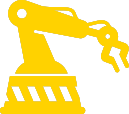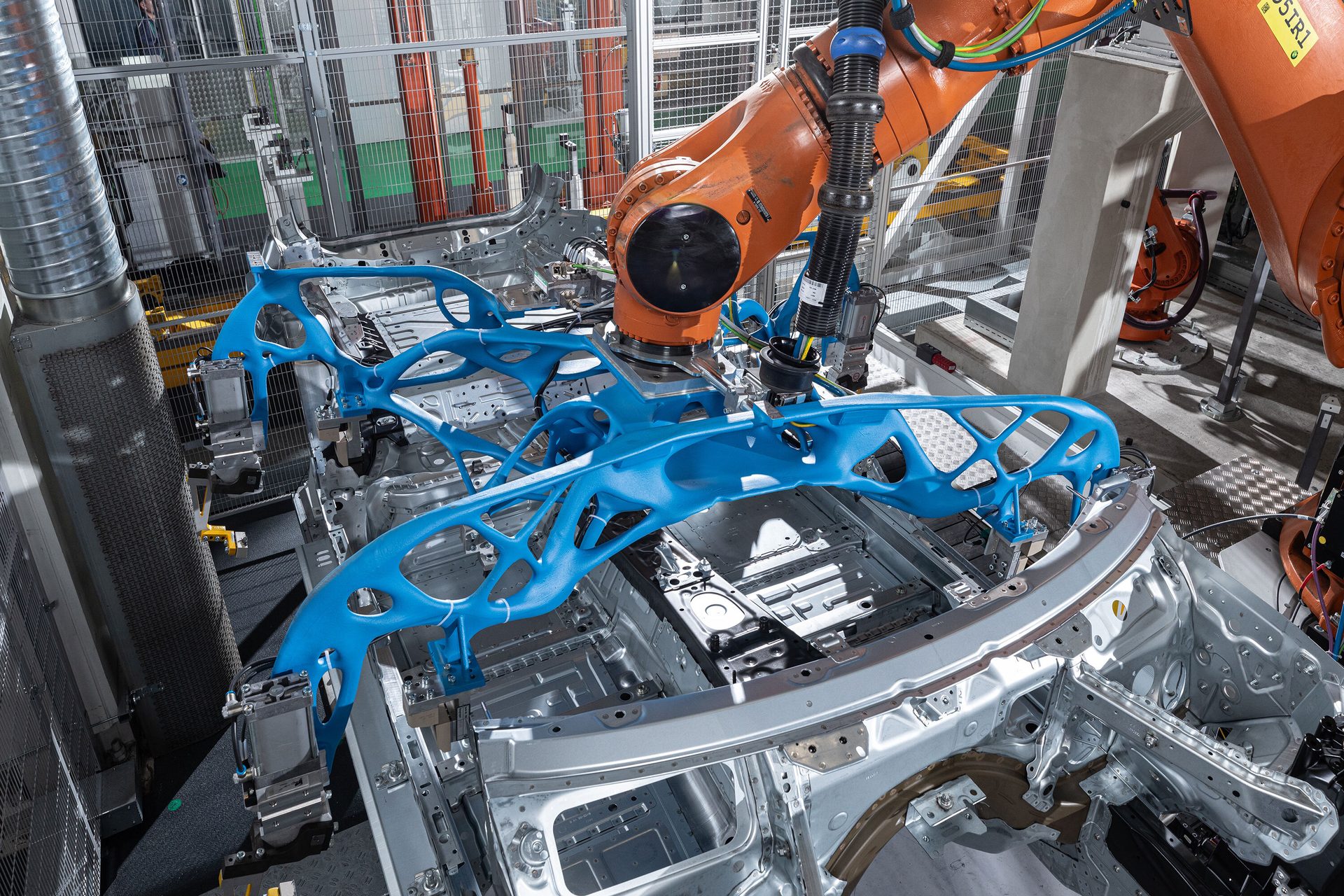AUTOMATION REVIEW

CONTACT
Austin

Lightweight battery-powered aircraft are ready for take-off.
Start-up EV Company Automates Assembly
Kristin Roth // Marketing Representative // Dürr Systems AG // Bietigheim-Bissingen, Germany
Dürr Systems provides automated paint line, final assembly, and inspection and test systems for Turkish EV manufacturer.
Some 250 robots are employed throughout the plant, which can produce 20 vehicles per hour. Photo courtesy Togg
AUTOMATION REVIEW PRODUCTS
Everyone is getting into the electric vehicle manufacturing business these days. Besides the U.S. and China, EV start-ups are popping up in Australia, Finland, India and Vietnam, just to name a few. One of the newest is in Turkey.
Togg is a new EV OEM headquartered in Gebze, a suburb of Istanbul. The company was founded as a joint venture by five Turkish companies in 2018. (The company’s name is an acronym of Türkiye’nin Otomobili Girişim Grubu, which translates to Turkey’s Automobile Joint Venture Group.) In 2022, Togg opened its first assembly plant in Gemlik, about 80 southeast of Istanbul, next to the company’s subsidiary, Siro, which produces lithium-ion batteries for EVs.
Sales of the first vehicle, the Togg T10X, a compact crossover SUV, started in March 2023 and quickly took off. Togg sold 4,145 vehicles in the first three months of 2024, surpassing its closest competitor by 2,533 units. The company’s market share in the EV market in Turkey now stands at 30 percent.
Sales are expected to grow from there. The company’s second model, the T10F fastback sedan, was unveiled in January at the 2024 Consumer Electronics Show in Las Vegas. Togg is expected to manufacture three other models, a hatchback, a midsized SUV, and a multipurpose vehicle, by 2030.
Let Fusion help streamline your brazing or soldering process! We transform manual processes into turnkey automation systems, providing years of cost-efficient production. Cut labor costs, increase production, and optimize output. Ready to learn more? Visit our website or contact us for a free consultation!
Fusion Incorporated
440-946-3300 / 800-626-9501
Automated Brazing and Soldering Machines
Togg’s timing could not be better. Some 14,158 fully electric cars were sold in Turkey in the first quarter of 2024, a 275 percent increase from the previous quarter. Fully electric cars now represent 6 percent of vehicle sales in the country, while hybrid cars account for 14 percent of sales.
Togg is expected to produce a total of 1 million vehicles by 2032, according to Fatih Kacır, Turkey’s industry and technology minister. “The target is to manufacture 175,000 Togg vehicles in five years,” he predicts. “Charging stations with 1,662 outlets are now available in 81 provinces of Turkey.”
A Better Paint Shop
Meeting such ambitious targets requires automation, and Togg’s Gemlik assembly plant is state of the art. Some 250 robots are employed throughout the plant, which can produce 20 vehicles per hour. The facility is also one of the most environmentally friendly auto plants in Europe.
Dürr Systems planned and built the paint shop and supplied systems for final assembly, test and inspection.
The turnkey paint shop project was awarded to Dürr in 2020, and the order for the final assembly system followed in 2021. Dürr covered all plant engineering and application technology, including marrying bodies and chassis, and final test and inspection.
This 30 foot structural steel frame on top of our TMF5000/40 forty station Fixed Rotary Index Table was designed and engineered by MID. Fully loaded, this indexer will hold 40 fixtures and parts arrayed around the structural steel frame to hold molds our customer is using to manufacture foam products for helmets.
Motion Index Drives
877-978-1830
Fixed Rotary Index Tables with Frame for Automation
Togg boasts that its paint line is the cleanest in Europe.
“The pretreatment and cathodic electrocoating systems are already rated for Togg’s final expansion stage, while plans include provision for doubling up of all other power units in the layout,” explains Bruno Welsch, president and CEO of Dürr’s paint and final assembly division. “As a result, Togg can react quickly if capacity requirements increase. The company can add a second oven or even an entire line.”
Togg opted for a lean painting process to minimize energy demand. The base coat and clear coat of the internal and external paint finish are applied in a single topcoat line with integrated primer application, eliminating one drying phase. The solvent-based paints contain 30 to 35 percent more solid content than standard paints to achieve the required layer thicknesses with lower discharge rates.
Six-axis robots paint vehicle bodies. Photo courtesy Togg
Dürr’s EcoDryScrubber dry separation system concentrates the solvents released into the exhaust air automatically and separates the overspray, which saves resources. The system requires virtually no water and very little energy for air conditioning, which is usually one of the highest energy consumption processes in painting. Spray booth air recirculation of up to 95 percent means that heat and electricity consumption are reduced by up to 80 percent and 50 percent, respectively. This reduction also pays off economically, with energy consumption reduced by up to 60 percent.
Togg goes well beyond the legal requirements with one additional measure to protect the environment. Dürr’s Oxi.X, a regenerative thermal oxidizer (RTO) disposes of the booth exhaust air. To save energy, the RTO can be operated auto thermally—in other words, without a primary energy supply for the burner.
Next-generation Dürr robots apply the paint, including the seven-axis EcoRP E043i, which is mobile enough to paint open tailgates and doors from the inside. A unique technical feature is the EcoBell 3 atomizers equipped with two main needles, which apply colored clear coats for particularly shiny surfaces. The second main needle eliminates time-consuming rinse cycles, reducing detergent consumption and ensuring the fastest color changes within the required cycle time.
Automation requires reliable, efficient components to keep systems moving forward. Demag Gear Motors and Wheel Solutions are engineered for guaranteed compatibility and flexible to meet your requirements. Unilateral motion of heavy loads with the Demag Wheel Block design, protecting the bearing and wheel from outside forces. Learn More!
DEMAG Cranes and Components
Moving Forward with Demag Gear Motors & Wheels
This test stand automatically calibrates driver assistance systems, such as the surround-view camera, forward-looking camera and forward-looking radar. Photo courtesy Dürr Systems AG
Automated Assembly
NEXT.assembly, Dürr’s bundled technology system for final assembly, is the basis for the assembly line at the factory. In the past, automotive assembly lines were often designed one segment or process at a time. With Dürr’s NEXT.assembly concept, the final assembly line is considered as a whole unit, making vehicle assembly as efficient as possible.
“Togg is the first car manufacturer to choose a complete system from our final assembly offerings. We developed a highly customized, resource-conscious system that results in high synergy and efficiency at all levels along the whole line with precisely coordinated processes,” reports Andreas Hohmann, vice president for consulting and NEXT.assembly at Dürr.
Dürr’s overhead conveyors ensure efficient transfer of parts and subassemblies. A total of 57 lightweight overhead conveyors transport vehicle doors on a separate assembly line. Another 50 heavy-duty overhead conveyors transport vehicle bodies. With the potential for future digitization, subsequent process integration or the addition of maintenance analysis tools is possible.
At this automated test stand, sensors provide 3D measurements of axle geometries and align them with a high level of precision and reliability. Photo courtesy Dürr Systems AG
One way Togg saves material on the door line is through precise dispensing of adhesives and sealants with Dürr’s EcoShot meter, which is suitable for almost all thick materials. Capable of metering both one- and two-part materials, the system can also dispense urethane adhesives for window bonding. At Togg, EcoShot is part of a fully automatic system for bonding windows and panoramic glass roofs. The process happens while vehicle bodies are being conveyed, making it more efficient than the typical stop-and-go process, where the conveyor must stop for window installation.
The process of marrying vehicle bodies and chassis occurs on a line divided into seven stations, including a fully automatic screwdriving station with six spindles. They fasten the front-axle module, the battery and the rear-axle module automatically at a total of 30 attachment points. At a downstream station, assemblers manually install screws at an additional 14 attachment points.
Some 50 heavy-duty overhead conveyors transport vehicle bodies throughout the plant. Photo courtesy Togg
The latter process can be easily automated in the future.
EVs do not require motor oil or gasoline, of course. However, EVs do have other fluids that need to be dispensed during final assembly, including battery coolant, transmission fluid, brake fluid, power steering fluid and windshield washer fluid. Dürr’s ProLine Cube system fills these fluids quickly and accurately.
At the end of the line, EVs are inspected and aligned at two wheel alignment stands. The stands are equipped with Dürr’s new x-3Dsurface sensors. These provide 3D measurements of axle geometries and align them with a high level of precision and reliability.
Dürr also provided technology for headlight measurement and adjustment, as well as calibration of driver assistance systems, such as the surround-view camera, forward-looking camera and forward-looking radar. Another test stand checks the brake systems.
ASSEMBLY ONLINE
For more information on automotive assembly, visit www.assemblymag.com to read these articles:
“A company with Ford’s scale can really influence the supply chain and business practices across our entire industry,” adds Sue Slaughter, purchasing director at Ford Motor Co. “It is so important that we not only think about how [we] can use our purchasing power to fuel our business needs, but also to advance sustainability.”
Because the automotive supply chain is extremely complex, the Guiding Principles contain expectations about business ethics, working conditions, human rights, health and safety, environmental leadership and supply chain due diligence for suppliers at all tiers. All suppliers are expected to uphold these standards and enforce them throughout their supply chain.
The Guiding Principles are based on fundamental elements of social, environmental and governance responsibility that are consistent with applicable laws and international standards created by organizations such as the United Nations.
Topics covered under the revised guidelines include the following:
Business ethics, including counterfeit parts and data protection.
Environmental issues, such as air quality, carbon neutrality, chemical management, circularity and water management.
Health and safety issues, such as personal protective equipment and workspace.
Human rights and working conditions, such as benefits, wages and working hours.
Responsible supply chain management, such as ethical sourcing of raw materials.
The BMW Group has implemented several projects in its packaging logistics unit to help the environment and conserve resources. The goal of the initiative is to work closely with suppliers to reduce carbon emissions and adhere to the principles of a circular economy.
BMW’s European assembly plants are using more recycled material in their packaging. For newly awarded contracts, the proportion of recycled material in reusable packaging for logistics purposes will almost double this year from around 20 percent to over 35 percent.
Using alternative sustainable materials, reducing single-use packaging, introducing lightweight packaging in certain areas and reducing transport volumes will also help cut carbon emissions.
BMW is monitoring the impact of individual measures via a CO2 calculator for packaging. The automaker’s overall aim is to reduce CO2 emissions in the supply chain by 20 percent per vehicle compared to 2019.
“Our re:think, re:duce, re:use, re:cycle approach is being implemented consistently in packaging logistics,” says Michael Nikolaides, head of production network and logistics at BMW Group. “We’re using innovative strategies to consistently reduce the volume of resources we use, thus reducing our carbon footprint.
“We are also doing our part to get the BMW iFACTORY up and running, with a particular focus on the ‘green’ side of things…with an emphasis on flexibility and efficiency, sustainability and digitalization,” explains Nikolaides. “It provides an answer to the challenges involved in the transformation to e-mobility and [leverages] the latest technologies to create a production process that uses minimal resources.”
According to Nikolaides, BMW is using more recycled material, such as expanded polypropylene (EPP) packaging. “Our newly developed EPP packaging already contains 25 percent recycled material,” he points out. “EPP is used in special containers, as its shape can be adapted to the components being packaged, allowing them to be transported safely.
“Around 360,000 of these containers are needed each year,” claims Nikolaides. “Using 25 percent recycled material allows us to save almost 280 tons of CO2 annually. There are plans to increase this proportion of recycled material even further, with the first pilot schemes with 100 percent recycled material currently underway. If these tests are successful, this configuration will become standard for new contracts from 2024.
“An additional 680 tons of carbon emissions savings can be made every year by using covers and so-called small load carriers with 50 percent recycled contents,” says Nikolaides. “As things stand, these measures are focused within the European markets due to the current waste management situation and available recycling infrastructure. But, we are working toward expanding to our locations in China, Mexico and the United States.”
BMW also plans to use folding large load carriers in place of traditional pallet cages made of steel. The plastic alternatives will be made from over 90 percent recycled material. They work in a similar way to the collapsible shopping crates that most people are familiar with.
When they’re empty, the carriers can be folded up, making them easier to transport. Nikolaides claims that using 15,000 of these new containers will reduce CO2 by around 3,000 tons per year.
“When it comes to packaging, the sky’s the limit,” says Nikolaides. “We’re launching pilot projects using bio-based materials to replace oil-based substances such as polyethylene and polypropylene.
“We are also investigating whether and in what ways we can use materials from recycled household appliances in our packaging,” explains Nikolaides. “In the long term, our aim is to use alternatives to raw materials across the board.”





